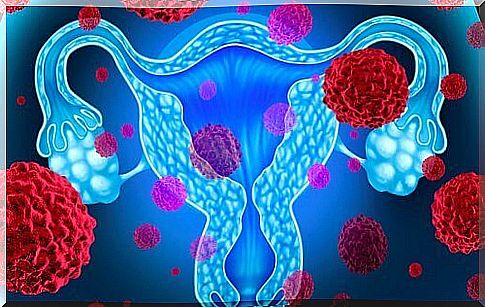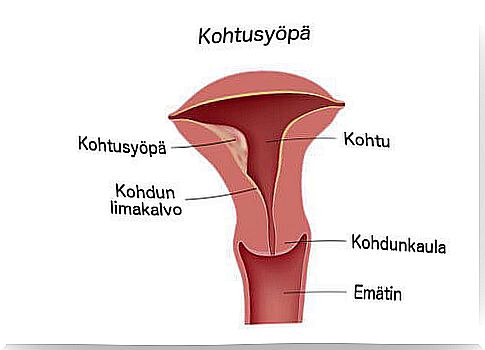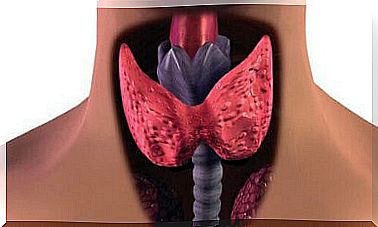Uterine Cancer: Keep These 5 Things In Mind

According to recent studies, one in 100 women develops uterine cancer (cancer of the womb). It is the most common form of cancer in postmenopausal women. Uterine cancer is a common cancer in women, but it is not the most deadly of the cancers. Early diagnosis improves the prognosis of the disease.
The causes of uterine cancer are not yet fully known, but persistent changes in estrogen levels can lead to an increased number of cancer cells in the uterine lining. In this article you will find more information about uterine cancer.
Uterine cancer: this is what you should know
In order to better understand how the disease develops and grows, we must first examine the uterus and its structure in more detail.
1. The uterus and its changes during the menstrual cycle
- The uterus is part of a woman’s genitals and is responsible for fetal development during pregnancy. The uterus provides the developing child with a safe environment in which to grow from fetus to full-size baby. The uterus consists of two different parts: the cervix (the lower part that extends into the inside of the vagina) and the uterus itself, which is a sac-like organ in the upper part of the cervix.
- The uterus has three layers: the innermost is the lining of the uterus, the middle is the uterine muscle, and the outermost is the peritoneum.
- During the menstrual cycle, female hormones alter the composition of the uterine lining of the uterus.
- During ovulation, estrogen is released, causing mucosal thickening. This is because the uterus is preparing to receive a fertilized egg during a possible pregnancy.
- When ovulation is over and the menstrual cycle is complete, the thickened mucosa is removed from the uterus during menstrual bleeding.
- The same thing happens from month to month until menopause, when menstruation ends.
Uterine cancer is the third most common cancer in Finnish women. Menopause usually begins at the age of 50-60 and at the same time the risk of developing uterine cancer increases. Cellular changes are more sensitive and malignant cells can adhere to the innermost membrane of the uterus.
The development of cancer usually begins when, for some reason, normal cells in the mucosa begin to become malignant. In about 95% of cases, the glandular cells become malignant, in which case the cancer is called endometrial adenocarcinoma.
When cancer of the uterine body begins in muscle tissue, we speak of sarcoma. Cervical cancer can grow locally on the uterine wall or spread to its surroundings, for example, the cervix, the outer surface of the uterus, the uterine organs, the bladder, or the intestines.

2. Overweight and high blood pressure: two risk factors
As we mentioned at the beginning of the article, researchers have not yet been able to fully understand the reasons why uterine cancer develops. Nevertheless, experts say there are certain risk factors that can lead to harmful changes in the cells of the uterine lining. The two best known of these are high blood pressure and overweight.
- Adipose tissue that accumulates in the body increases the chance of developing high cholesterol. High cholesterol alters metabolism and can lead to changes in estrogen levels.
- The effect of estrogen is seen especially in breast tissue, uterus and vagina, so drastic changes in estrogen levels can increase the risk of developing cancer.
The link between being overweight and cancer has not been 100% proven, but studies have shown that being overweight can predispose to the development of cancer. People who are normally overweight have fewer cancers than those who are overweight.
3. Tamoxifen may increase the risk of uterine cancer
- Tamoxifen is often used to treat breast cancer, and unfortunately it can predispose you to developing uterine cancer. This is important to keep in mind if you have breast cancer and are taking tamoxifen to treat it.
- Tamoxifen can cause changes in the amount of hormones, which in turn can predispose to harmful changes in the uterus.
- Despite the danger, doctors still prescribe tamoxifen to breast cancer patients because when the drug’s predisposing effect on uterine cancer is known, possible symptoms can be detected in time and the condition of the uterus monitored regularly.
4. Symptoms of uterine cancer

- Bleeding between periods or after menopause
- Constant and severe abdominal pain
- Feeling of pressure and stabbing pain in the hips and lower back
- Severe pain during intercourse
- Pain when urinating
5. Uterine cancer prevention and regular check-ups
Uterine cancer begins in the inner lining of the uterus. Uterine cancer may not show up in a pap test unless it has had time to spread to the cervix.

Older women should seek medical attention immediately if menstrual bleeding changes or bloody vaginal bleeding occurs after menstruation has stopped. The uterus can be examined by taking a sample of uterine tissues that is examined in a laboratory. Ultrasound imaging can also be used to check the condition of the uterus and find possible tumors.
If you have a family history of uterine cancer or other cancers in women, it is recommended that you have regular health check-ups. The chance of surviving uterine cancer is high and it is possible to cure it. The key to stopping the progression of the disease is early diagnosis and treatment.









